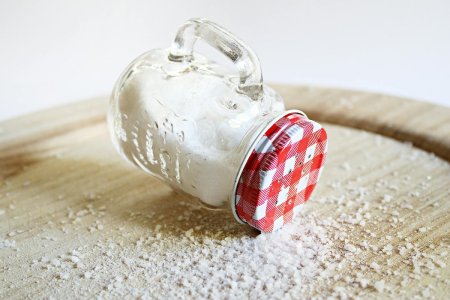A simple change that could lower your stroke risk by 14%—here’s what researchers found!
By
Veronica E.
- Replies 0
Disclaimer: The information provided in this article is for educational purposes only and is not intended as a substitute for professional medical advice, diagnosis, or treatment. Always consult your physician or other qualified healthcare providers with any questions you may have regarding a medical condition or before making any changes to your health regimen.
As we get older, taking care of our health becomes more important than ever. And for many, preventing a stroke—or avoiding a second one—is a top priority.
While we can’t control everything, the good news is that small changes can make a big difference.
In fact, new research has uncovered a simple dietary tweak that could significantly lower your risk of stroke. The best part? It doesn’t require a drastic lifestyle overhaul!
Sodium chloride, or salt, plays an essential role in our bodies, helping with nerve function, muscle movement, and fluid balance. But as with many things in life, too much of a good thing can become a problem.
The American Heart Association (AHA) recommends no more than 2,300 milligrams of sodium per day, with an ideal limit of 1,500 mg. Unfortunately, most Americans consume nearly 3,500 mg daily—far exceeding these guidelines.

Excess sodium is a major contributor to high blood pressure, one of the leading risk factors for stroke. And if you’ve already had a stroke, the chances of experiencing another one are high—1 in 4 survivors suffer a second stroke.
But what if simply swapping out one ingredient in your diet could help lower that risk?
Researchers in China recently conducted a groundbreaking study, published in JAMA Cardiology, that explored the impact of using a salt substitute. The study followed over 15,000 people—average age 64—all of whom had previously suffered a stroke.
Participants were divided into two groups: one continued using regular salt, while the other switched to a salt substitute made of 75% sodium chloride and 25% potassium chloride.
After five years, researchers found some eye-opening results.
The group using the salt substitute saw:
While this change may seem small, the benefits are clear—choosing the right salt could have a big impact on your health.
Switching to a salt substitute is one way to reduce sodium intake, but it's not the only option.
Most of the sodium we consume comes from processed and packaged foods, so being mindful of our choices can make a big difference.

Here are some simple ways to cut back on sodium without sacrificing flavor:
Making even small adjustments to your diet can have long-term benefits.
If you’re considering switching to a salt substitute, talk to your doctor—especially if you have kidney disease or other health conditions that may be affected by potassium intake.

Here at The GrayVine, we believe that simple, everyday choices can help us live longer and healthier lives. Have you tried using a salt substitute or found other ways to cut back on sodium? Share your thoughts in the comments below—we’d love to hear from you!
Related articles:
Are you at risk? The surprising return of iodine deficiency could affect YOU!
Experts share 5 tactics to banish artificial sweeteners out of your life for good
Dietitians won't stop talking about this perfect late-night snack for insulin resistance!
As we get older, taking care of our health becomes more important than ever. And for many, preventing a stroke—or avoiding a second one—is a top priority.
While we can’t control everything, the good news is that small changes can make a big difference.
In fact, new research has uncovered a simple dietary tweak that could significantly lower your risk of stroke. The best part? It doesn’t require a drastic lifestyle overhaul!
Sodium chloride, or salt, plays an essential role in our bodies, helping with nerve function, muscle movement, and fluid balance. But as with many things in life, too much of a good thing can become a problem.
The American Heart Association (AHA) recommends no more than 2,300 milligrams of sodium per day, with an ideal limit of 1,500 mg. Unfortunately, most Americans consume nearly 3,500 mg daily—far exceeding these guidelines.

Too much salt? Excess sodium intake can increase the risk of high blood pressure and stroke. Image Source: Pexels / Lorena Martínez.
Excess sodium is a major contributor to high blood pressure, one of the leading risk factors for stroke. And if you’ve already had a stroke, the chances of experiencing another one are high—1 in 4 survivors suffer a second stroke.
But what if simply swapping out one ingredient in your diet could help lower that risk?
The Study That’s Shaking Up Stroke Prevention
Researchers in China recently conducted a groundbreaking study, published in JAMA Cardiology, that explored the impact of using a salt substitute. The study followed over 15,000 people—average age 64—all of whom had previously suffered a stroke.
Participants were divided into two groups: one continued using regular salt, while the other switched to a salt substitute made of 75% sodium chloride and 25% potassium chloride.
After five years, researchers found some eye-opening results.
Also read: Surprise your taste buds: 11 grocery items hiding a shocking amount of salt
The Results: A Dash of Hope
The group using the salt substitute saw:
- A 14% lower risk of having another stroke
- A 30% lower risk of hemorrhagic stroke (caused by bleeding in the brain)
- A 12% lower risk of death from any cause
- A 21% lower risk of stroke-related death
- A modest but meaningful drop in systolic blood pressure
While this change may seem small, the benefits are clear—choosing the right salt could have a big impact on your health.
Spicing Up Your Life Without the Salt
Switching to a salt substitute is one way to reduce sodium intake, but it's not the only option.
Most of the sodium we consume comes from processed and packaged foods, so being mindful of our choices can make a big difference.

Processed foods can be a hidden source of excess sodium—checking labels can help you make healthier choices. Image Source: Pexels / Tim Samuel.
Here are some simple ways to cut back on sodium without sacrificing flavor:
- Read Labels – Choose low-sodium or no-sodium-added options when shopping.
- Cook at Home – Making your own meals allows you to control the amount of salt used.
- Flavor with Herbs & Spices – Experiment with garlic, lemon, rosemary, and other seasonings.
- Choose Fresh Foods – Whenever possible, opt for fresh fruits and vegetables over canned or processed ones.
Making even small adjustments to your diet can have long-term benefits.
If you’re considering switching to a salt substitute, talk to your doctor—especially if you have kidney disease or other health conditions that may be affected by potassium intake.
Key Takeaways
- Researchers in China found that using a salt substitute can reduce the risk of recurrent stroke by 14%, particularly for individuals who have already experienced a stroke.
- The study involved participants using a salt substitute composed of 75% sodium chloride and 25% potassium chloride, instead of regular table salt, which is nearly 100% sodium chloride.
- Over a study period of just over five years, the group using the salt substitute also experienced lower all-cause mortality rates and reduced blood pressure.
- While the reduction in stroke recurrence and mortality was significant in the study group, researchers caution that results may vary globally due to differences in dietary sodium sources, such as packaged foods.
Here at The GrayVine, we believe that simple, everyday choices can help us live longer and healthier lives. Have you tried using a salt substitute or found other ways to cut back on sodium? Share your thoughts in the comments below—we’d love to hear from you!
Related articles:
Are you at risk? The surprising return of iodine deficiency could affect YOU!
Experts share 5 tactics to banish artificial sweeteners out of your life for good
Dietitians won't stop talking about this perfect late-night snack for insulin resistance!





